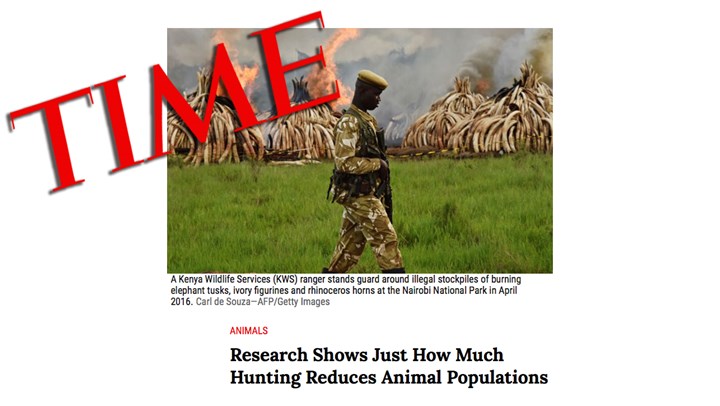
by Brian McCombie - Saturday, April 29, 2017

According to a recent and extremely inaccurate article in Time magazine, “hunting” is responsible for all sorts of mayhem being committed upon the animal kingdom. As the magazine’s Mar. 13, 2017, article proclaimed, “Hunting has a devastating effect on animal populations … Researchers found that hunting on average leads to an 83 percent reduction in mammal populations within 25 miles of hunter access points like roads and towns.” These “hunters” are wreaking havoc on bird populations, too, Time noted, leading to a 58-percent decline in avian numbers near the above-mentioned roads and access points.
Unfortunately, here is yet another example of the mainstream media being unable—or unwilling—to draw any distinction between the conservation-based hunting embraced in the United States and what Time should have more accurately termed “market hunting,” “poaching” or the slaughter of wildlife for monetary gain.
The North American Model of Wildlife Conservation is the world’s most successful. No other continent has conserved as many species of native wildlife as North America. While other countries struggle to conserve the wildlife they have left, we enjoy great abundance and diversity of wildlife.
The truth is that the North American Model of Wildlife Conservation—the world’s most successful—is based on regulated hunting and a series of principles, including the key concept that wildlife belongs to the public trust and, therefore, should not be exploited for private gain. That public trust includes, and in fact, insists upon scientific management of our wildlife and other natural resources. Hunting is one tool in that management, but is never allowed at levels that would threaten the various game populations.
But that was not what Time reported on, though the magazine doesn’t seem to realize its mistake.
Time based its recent article on a new study published in Science Daily. The study was from research conducted by faculty at the Department of Environmental Science at Radboud University in Nijmegen, the Netherlands, and focused on Third World countries in the tropical regions of Central and South America, Africa and Asia.
To its credit, the study at least mentioned market hunting and wildlife poaching in explaining what was really happening in these countries. Unfortunately, the authors also used the term “hunting” interchangeably with what should have been noted as illegal or non-conservation based activities. For facts on how poaching is not hunting, click here.
Essentially, the study Time reported on found that in countries without strict hunting laws and where conservation-based wildlife management is not enforced, wildlife populations are suffering. Simply put, people in these countries are killing off their wildlife to make money and/or to provide meat. If left unchecked, it’s very possible that some species in these areas could be wiped out—which is terrible. But what our mainstream media doesn’t understand is that conservation-based hunting actually improves wildlife populations—for the wildlife species being hunted as well as for numerous non-game species.
Consider that the United States entered the 20th century with deer, elk and turkey populations in steep decline, largely thanks to unrestricted “market hunting.” Today, all three species are thriving, precisely because conservation of our wildlife was adopted as the guiding principle.
But it was more than a principle. Hunter-conservationists put their money where their ideals were, funding a state and federal conservation program through their hunting (and fishing) licenses, as well as through a tax on firearms and ammunition that also goes directly to conservation efforts.
If Time and other mainstream publications want to cite research that examines hunting and its relationship to wildlife populations, they would do well to look up a 2015 study published in the journal Conservation Biology. This study examined trophy hunting in Africa and compared its economic impacts to what is loosely called “eco-tourism,” which includes everting from wildlife viewing to nature-hiking expeditions. The study focused on community-based “conservancies” that manage wildlife at the local level for hunting, eco-tourism or both.
Remove trophy hunting and you lose the income, employment and meat that trophy hunting generates for these communities and their people. In addition, the vast majority of these conservancies would no longer be making enough money to sustain themselves and their efforts.
While eco-tourism also brings in monies—and no one disputes that—as the researchers discovered, African trophy hunting was a much larger generator of income. It has led to these conservancies caring for their wildlife in various conservation-based ways. The wildlife here is seen as a community resource, and the local people protect it and nurture it accordingly.
And that, Time, is what real “hunting” is all about!
■ ■ ■
Editor's Note: As highlighted regularly on NRAHLF.org, the National Rifle Association is committed to gong on offense to save the future of hunting and wildlife conservation. In fact, during the fall 2014 meeting of the NRA Board of Directors, NRA Hunting, Wildlife and Conservation Committee Chairman Richard Childress of NASCAR fame—and now NRA 2nd Vice President—recommended that the Board adopt the North American Model of Wildlife Conservation as NRA policy, which it did unanimously.
E-mail your comments/questions about this site to:
[email protected]
Proudly supported by The NRA Foundation and Friends of NRA fundraising.
